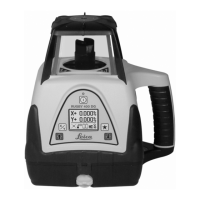
Do you have a question about the Leica Rugby 400 DG and is the answer not in the manual?
| Type | Rotary Laser Level |
|---|---|
| Self-Leveling | Yes |
| Self-Leveling Range | ± 5° |
| Laser Diode Type | 635 nm, Class 2 |
| Waterproof | Yes |
| Range | Up to 400 m with detector |
| Operating Range | Up to 400 m with detector |
| Operating Temperature | -10°C to +50°C |
| Rotation Speed | 600 RPM |
How to input grade values for X and Y axes using direct entry method.
Entering grade values using a numerical digit input method with cursor control.
Quick method to set grade values to zero for both X and Y axes simultaneously.
Details on the maximum grade percentages the Rugby 400DG can handle.
Swapping grade values between X and Y axes for different road building applications.
Procedure to match an existing slope using the laser and receiver.
Explains the X+ and Y+ axis directions and the front of the Rugby unit.
Defines slope and percent of grade, includes calculation example.
Steps to align the X and Y axes to the jobsite for accurate operation.
Guidance on selecting location, ground stability, and dust conditions for setup.
Recommended head speeds for different applications (surveying, machine control).
Instructions for securely attaching the Rugby to a tripod or stable surface.
Details on selecting head speeds (5, 10, 15, 20 rps) for optimal performance.
Explains the H.I. function for preventing elevation changes from tripod movement.
Explains automatic self-leveling and manual mode with self-leveling off.
How manual mode works with grade input and display.
Procedure to check the X-axis level accuracy against a wall.
Procedure to check the Y-axis level accuracy against a wall.
Steps to enter the accuracy adjustment mode for the Rugby unit.
How to adjust the X-axis accuracy using the controls.
How to adjust the Y-axis accuracy using the controls.
Information on battery types, installation, charging, and status.
Details on the optional sighting scope for alignment of axes.
Overview of the Rugby 400 DG remote control functions and operation.
How to align the crosshairs of the sighting scope for accurate setup.
How to put the Rugby into standby mode for power saving.
Automatic shut-off feature for the remote to conserve battery power.
Indication of low battery status on the remote control.
Steps to program the remote control to connect with the Rugby.
How to change the automatic shut-off timer for the remote.
How to activate the LCD backlighting on the remote.
Tips for ensuring good remote reception, including line of sight.
Explains various warning and status messages shown on the display.
Warning when the unit has moved and elevation may have changed.
Warning indicating the unit is not level or has a tilt issue.
Warning when the remote is out of range or not in line of sight.
Guidelines for transporting the product in the field and in vehicles.
Procedures for transporting the product by rail, air, or sea.
Recommendations for storing the product and batteries.
General safety guidelines for product users and responsible persons.
Specifies the permitted and adverse uses of the product.
Lists the intended applications and functionalities of the laser.
Lists prohibited actions and conditions for using the product.
Defines environmental conditions and hazardous areas for product use.
Outlines responsibilities of manufacturer, accessory makers, and person in charge.
Information on how to obtain international warranty details.
Details potential hazards and necessary precautions during product operation.
Cautionary notes regarding measurements, electrical installations, and accessories.
Danger warnings related to electrocution from electrical installations.
Warnings about thunderstorms, mechanical shock, and battery transport.
Describes the product's Class 1 laser classification according to IEC standards.
Details the laser classification and safety labeling of the product.
Defines Electromagnetic Compatibility and its importance for the product.
Precautions regarding using recommended accessories and cable connections.
FCC compliance and labeling information for the product and remote.